What three aviation marketing campaigns should you plan to build your business in 2019?
Here are our picks for the best business-building strategies, balanced with some revenue-generating ideas.
 So, first of all, what is a campaign and why is it important for aviation marketing?
So, first of all, what is a campaign and why is it important for aviation marketing?
A campaign is a way of organizing a temporary marketing effort that is designed to get maximum effect.
Every campaign includes three elements:
- A List
- An Offer
- and a Presentation.
Many companies, and even marketing companies, focus on the Presentation bit and provide very limited attention to the other two elements.
The reason many marketing efforts fail is because one of these elements was simply not planned carefully enough.
[embedyt] https://www.youtube.com/watch?v=Gsz3PQWn-p8[/embedyt]
[smart_track_player url=”http://traffic.libsyn.com/aviationmarketing/AMHF_0156_-_Three_Campaigns_for_podcast.mp3″ background=”default” ]
 Consider The Strategy and Goals.
Consider The Strategy and Goals.
The first thing to consider- is your intention with this campaign? Is it to find new prospects? That will require a long-term strategy.
Is your goal to generate more revenue this quarter? That’s a short-term strategy.
A healthy business needs a good mix of both short and long-term strategies.
We planned three for you to use in 2019.
If you execute these three campaigns next year, you will end the year with a full pipeline and and stronger revenue!
Here are the Three Aviation Marketing Campaigns we Recommend for 2019
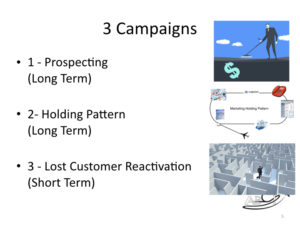 Prospecting (A long term strategy)
Prospecting (A long term strategy)- A Holding Pattern (Another long-term strategy)
- A Lost Customer Reactivation Campaign. (A short-term campaign.)
As you look at your clean new 2019 calendar, you can plan to focus on one of these at a time.
They can be used in any order that makes sense based on your business needs.
An idea for an older, established brand: Start the year with a Lost Customer Reactivation campaign that runs through Valentine’s Day. (Campaign #3.) Then focus on Prospecting during the aviation trade shows of the spring and early summer. (Campaign #1) Then, develop a strong Holding Pattern later in the year to improve conversion and retention of those prospects in fall.
If you’re a brand new company, new to general aviation marketing or business aviation marketing, or one with few existing customers: Do these campaigns in order. Start the year with a big push for prospecting. (Campaign #1) Then build a strong Holding Pattern (Campaign #2) over the spring and summer months, and finish the year with a Lost Customer Activation (Campaign #3) to get back any customers you gained and lost during the year.
So, here are the details and instructions for each of these campaigns.
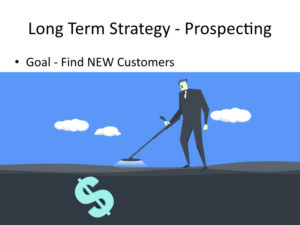 Campaign #1 – The Prospecting Campaign
Campaign #1 – The Prospecting Campaign
Prospecting is a well-known activity to any salesperson worth his salt, and any marketing course graduate.
The objective is to locate and identify prospects to expand your future market share and revenue.
In “inbound marketing” parlance, that means getting prospects to identify themselves by responding to a low-cost, low-risk offer.
The important things to do know about prospecting in the aviation industry are these:
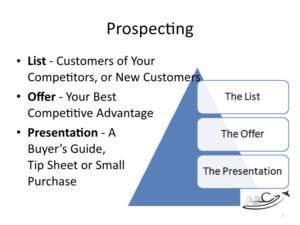 The List:
The List:
- There are great lists available of people involved in the aviation industry in various capacities.
- FAA licensing is a great source of data. There are several data providers that provide software and/or lists.
- Industry associations and periodicals sometimes let you “rent” their lists, or will distribute ads on your behalf in their magazine or online.
- People can be targeted online, using digital marketing tools, based on their interests, employers, positions and “likes”
- You can even target current customers of a competitor, if you have a better offer.
- You can target people new to the industry if you know some key characteristics that make them likely to want the solution you provide.
The Offer
- A Tip Sheet or Buyer’s Guide, a book or DVD offered for free or for at a very small cost are a way to begin a relationship at a low cost and a low risk to both sides.
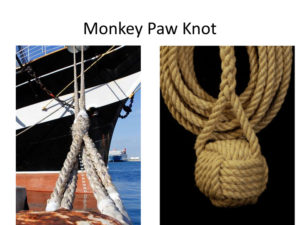 A small sample product, or a short-term agreement are all great offers for a first-time prospect.
A small sample product, or a short-term agreement are all great offers for a first-time prospect.- Since this is someone who doesn’t know you, your products or your company very well yet, it’s helpful to think of this as a small, lightweight “monkey paw” like those used by crews before they send over the big hawsers to tie up a ship. A monkey paw is a knot tied at the end of a light rope that’s easy for the people on both sides to manage.
The Presentation
Since this is our lowest-converting campaign type, we want to keep the cost pretty low.
- Great content (such as this podcast!) optimized with Search Engine Optimization for keywords prospects who need our help are likely to use.
- Targeted Online Advertisements (Facebook Ads)
- Occasional targeted low-cost mail (such as postcards) sent to a very specific list.
 The outcome of a prospecting campaign is future income.
The outcome of a prospecting campaign is future income.
The longer you’re in business, the better you know your own precise numbers. For us last year, the average amount of time between initial contact (in our, case a tip sheet download) and a purchase was about eight months.
And we know that a percentage (for us, about one in eight) of the people who download tip sheets eventually become customers.
So, by “selling” more tip sheets today, we’re making more revenue eight months into the future.
The longer you’re in business, and the better records you keep (usually in a CRM or Customer Relationship Management Database) the more reliable this data becomes, to use email marketing, digital and direct mail campaigns far into the future.
What we know for certain is that time and energy spent on a good Prospecting campaign with a great list, offer and presentation will pay off in the long term.
Campaign #2 – The Holding Pattern
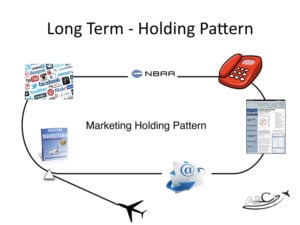 If you’re landing at Salt Lake International Airport during a busy Friday afternoon, you’ll often find yourself being told to enter a holding pattern over Redwood Road to wait for traffic.
If you’re landing at Salt Lake International Airport during a busy Friday afternoon, you’ll often find yourself being told to enter a holding pattern over Redwood Road to wait for traffic.
If you’re making a sale in the aviation industry, you (and your prospect) will often find yourselves being told to wait by the higher-ups in their company, or needing to wait on a budget, cash flow or seasonal issue.
It’s a mistake to simply allow weeks or months to pass, even if they tell you “I won’t be able to make this purchase until after the first of the year,” if it’s March. You can bet that many things will happen, their circumstances may change, and they’ll be approached by competitors in the intervening time.
So, you need to stay in touch with these prospects. At the same time, you don’t want to seem like a pest or drive them (or yourself) crazy or spend too much money on marketing materials, site visits and phone calls.
The List
Your list of prospects that have not yet consummated a deal, but need additional information or time before making a decision.
The Offer
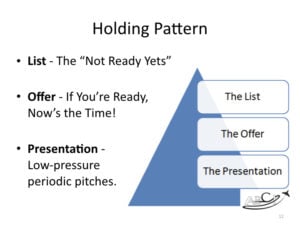 The offer should be pretty low-key. “If you’re ready, now’s the time!” You can make periodic offers to build urgency, but in the aviation industry the timing of purchases is often outside of our control and the prospects. If they’re waiting on a regulatory approval, for example, dropping your price is usually not going to make things happen any faster! It will just ruin your credibility when it finally comes time to sign and they’ve missed your deadline.
The offer should be pretty low-key. “If you’re ready, now’s the time!” You can make periodic offers to build urgency, but in the aviation industry the timing of purchases is often outside of our control and the prospects. If they’re waiting on a regulatory approval, for example, dropping your price is usually not going to make things happen any faster! It will just ruin your credibility when it finally comes time to sign and they’ve missed your deadline.
The Presentation
Make contact in some way once a week, or at least once every two weeks. You can make these contacts varied and low-key. Select from items listed below.
- Offer a tip of the week by email
- Connect via social media. (LinkedIn, Facebook and Twitter are the most commonly used media in our industry.)
- Send birthday and holiday greeting cards.
- Send a printed newsletter.
- Meet them for coffee or a meal when you happen to be in their town or at a trade show together.
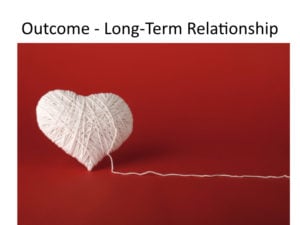 This is a time when a good CRM (customer relationship management) database comes in handy. You can send emails automatically, print a set of labels for newsletters, and pull up a list of prospects in your “holding pattern” (or on your “house list”) when you’re visiting a particular city. The longer you’re in business, the longer your list of prospects and the harder it is to keep all the data straight without artificial help.
This is a time when a good CRM (customer relationship management) database comes in handy. You can send emails automatically, print a set of labels for newsletters, and pull up a list of prospects in your “holding pattern” (or on your “house list”) when you’re visiting a particular city. The longer you’re in business, the longer your list of prospects and the harder it is to keep all the data straight without artificial help.
The outcome of a great holding pattern is a long-term relationship. Whether this person becomes a customer directly, refers business to you, or becomes a partner of some kind, every relationship in the small world of possible prospects for an aviation product or service is valuable.
So, remembering that the relationship is more important in the long run than the sale really helps to keep the Holding Pattern going.
Campaign #3 – Lost Customer Reactivation
Our third campaign is our most profitable by far.
Many people are hestitant to “chase” customers they lost. It’s embarrassing to go after someone after a breakup!
 But, this is business, and circumstances do change.
But, this is business, and circumstances do change.
The reason business relationships break up is often not due to any bad behavior on anyone’s part, but there is turnover. They may have been approached by a competitor who said they could do things better or cheaper. That person may or may not have delivered on those expectations.
The List
- Former customers who have not done business with you for a year or more. (Brokers might want to consider an interval of 3 years or more – whatever the typical amount of time passes between transactions. If you have a customer that books charter flights every month or so, you’ll want a shorter horizon than a business jet broker whose customers make upgrades or changes every three to five years.
The Offer
 This campaign works best if you can identify why they left. Was it because of price? A service they needed that you didn’t offer at the time? People turnover? Something else?
This campaign works best if you can identify why they left. Was it because of price? A service they needed that you didn’t offer at the time? People turnover? Something else?- Explain what’s new.
- Many people just need to be invited to do business with you again. They may have forgotten that you provide great service. They may have gotten busy and forgotten to renew their service.
The Presentation
- We LOVE doing Lost Customer Reactivation Campaigns around Valentines’ Day.
- Send a small box in the mail with Valentine’s Day candy and/or small novelties and some literature.
- “We miss you! We’d like to do business with you again.”
- “Here’s what’s changed about our business since we last did business with you.”
- Package followed by a phone call followed by two or three emails is a great multimedia cadence for this campaign.
The Outcome –
 We have NEVER run a Lost Customer Reactivation campaign without a positive return on investment.
We have NEVER run a Lost Customer Reactivation campaign without a positive return on investment.
Why?
Former customers already know, like and trust you, so there’s a very high likelihood that some of them will want to do business with you again.
I’ve been amazed at getting ads from retailers AFTER I’ve just made a purchase.
Retailers know that people who are already buying their products and services are the best source of future business. This is the basis of all the loyalty programs out there today. They run on teh same principles that make a Lost Customer Reactivation campaign successful.
Plan these three campaigns for 2019,
You’ll find that your sales are up, your frustration is down. And the best part is that it’s easier to tweak and repeat a successful campaign, so you can keep using these for years to come!
More articles about Aviation Marketing Campaigns
Looking for another example of a b2b direct mail campaign? We used this one with good results last year…
Three Ways Aviation Professionals Can Use a Retargeting or Recapture Campaign to Sell More Stuff!
AMHF 0010 – Budgeting and Holiday Campaigns
AMHF 002 – Why Bother with Marketing Campaigns?
ABCI’s Marketing Funnel By the Numbers – Direct Marketing Campaign Examples
Is Your Company Too Boring For Campaigns? Try this:
Four Great Holiday Campaigns for Aviation Companies – And One Bad One
Fixing a Broken Marketing Campaign – What Can We Simplify?
The Most Common Reason Marketing Campaigns Fail
Size Matters! Campaigns for Large and Small Aviation Transactions
Podcast: Play in new window | Download
Subscribe: Spotify | Amazon Music | RSS
